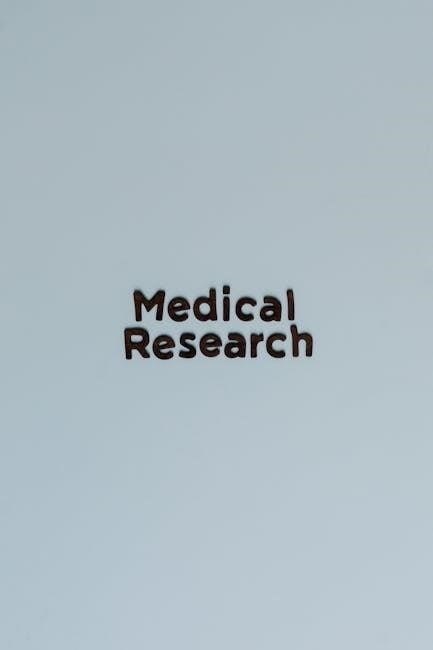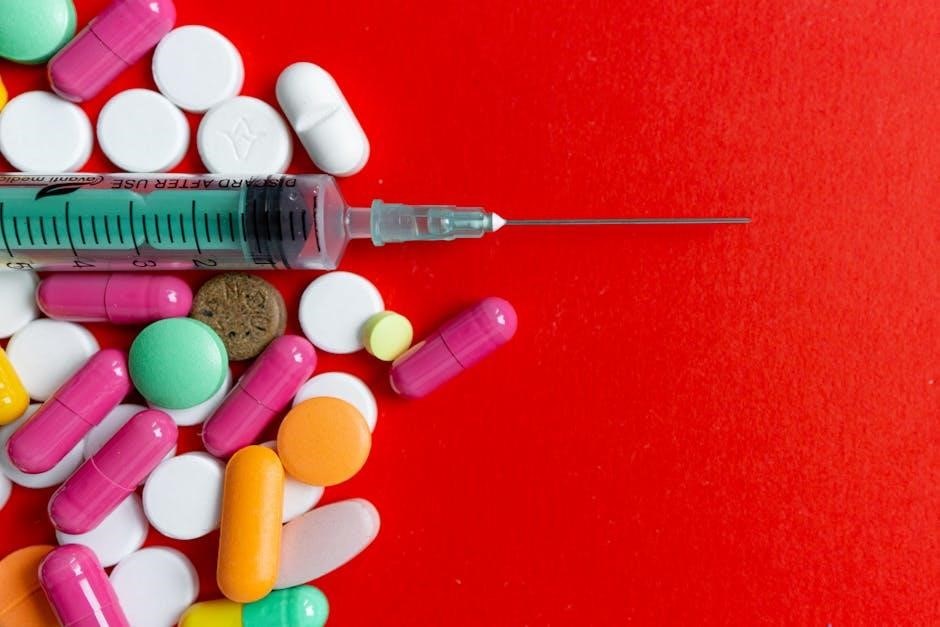Pharmacology is the science studying drug interactions with biological systems, crucial for medicine, pharmacy, and nursing. It explores drug origins, properties, effects, and therapeutic uses, ensuring safe and effective treatments.
1.1 Definition and Scope of Pharmacology
Pharmacology is the scientific study of drug interactions with biological systems, focusing on their chemical properties, biological effects, and therapeutic uses. It spans drug discovery, mechanisms of action, and clinical applications, serving as a foundation for medicine, pharmacy, and nursing, ensuring safe and effective patient care.
1.2 Importance of Pharmacology in Healthcare
Pharmacology is vital for developing safe and effective medications, understanding drug interactions, and optimizing therapeutic outcomes. It guides personalized medicine, improves patient safety, and enhances healthcare delivery across fields like nursing, medicine, and pharmacy, ultimately advancing public health and quality of life.
1.3 Key Concepts in Pharmacology
Key pharmacology concepts include pharmacokinetics (drug absorption, distribution, metabolism, excretion) and pharmacodynamics (drug effects on the body). Understanding drug interactions, therapeutic indexes, and dose-response relationships is essential. These principles guide safe and effective drug use, minimizing side effects while maximizing therapeutic benefits for patients.
Pharmacokinetics and Pharmacodynamics
Pharmacokinetics studies drug absorption, distribution, metabolism, and excretion, while pharmacodynamics examines drug effects on biological systems. Together, they explain how drugs move through and interact with the body, optimizing therapeutic outcomes and minimizing adverse effects.
2.1 What is Pharmacokinetics?
Pharmacokinetics is the study of how the body processes drugs, including absorption, distribution, metabolism, and excretion. It determines drug concentrations in the bloodstream and tissues, affecting efficacy and safety. Factors like dosage, route, and patient health influence pharmacokinetic processes, which are crucial for optimizing therapeutic outcomes and minimizing adverse effects.
2.2 What is Pharmacodynamics?
Pharmacodynamics is the study of the effects of drugs on biological systems, focusing on drug-receptor interactions and biochemical mechanisms. It examines how drugs alter physiological processes, including therapeutic and adverse effects. Key concepts include dose-response relationships, receptor binding, and how factors like patient health and drug interactions modify drug effects.
2.3 Relationship Between Dose and Effect
The dose-effect relationship describes how varying drug doses produce different magnitudes of therapeutic or adverse effects. This relationship is often graphically represented by a dose-response curve, showing the correlation between drug concentration and biological response. Understanding this principle is crucial for optimizing treatment efficacy and minimizing toxicity in clinical practice.
Drug Classification and Therapeutic Uses
Drugs are classified based on their mechanism of action, chemical structure, or therapeutic effects. This classification helps organize drugs, predict effects, and guide clinical decision-making for various medical conditions.
3.1 Classification of Drugs
Drugs are categorized by therapeutic use, chemical structure, or pharmacological effect. Common classifications include analgesics, antibiotics, antihypertensives, and anticonvulsants. This system aids in understanding drug functions, predicting effects, and ensuring safe, effective treatment regimens for diverse medical conditions, enhancing clinical decision-making and patient care outcomes significantly.
3.2 Common Drug Classes and Their Uses
Common drug classes include NSAIDs for pain/inflammation, beta-blockers for hypertension, ACE inhibitors for heart failure, and statins for cholesterol. Antidepressants, anticonvulsants, and antipsychotics manage mental health. Antibiotics target infections, while anticoagulants prevent clots. Understanding these classes aids in selecting appropriate therapies, improving patient outcomes, and optimizing treatment plans in clinical settings.
3.3 Therapeutic Effects and Side Effects
Drugs produce therapeutic effects through specific mechanisms, but side effects may occur. Analgesics relieve pain but can cause GI issues. Antihypertensives lower blood pressure but may induce dizziness. Understanding both effects is crucial for safe prescribing and patient care, balancing efficacy with potential risks in clinical practice.
Key Questions in Pharmacology
Common pharmacology questions include understanding drug mechanisms, side effects, and therapeutic uses. Students often ask about pharmacokinetics, drug interactions, and practical applications in patient care scenarios.

4.1 Common Pharmacology Questions for Students
Students often ask about drug mechanisms, side effects, and therapeutic uses. Key questions include understanding pharmacokinetics, drug interactions, and how medications affect specific conditions. These queries help build a foundation for clinical applications and patient safety in nursing and medical practices. Effective study guides address these core areas comprehensively.
4.2 Understanding Drug Mechanisms and Interactions
Understanding how drugs act on biological systems and interact with other medications is crucial. This involves studying pharmacokinetics, pharmacodynamics, and specific drug mechanisms, such as receptor binding or enzyme inhibition. Recognizing interactions, like beta-blockers reducing heart rate or anticoagulants preventing clotting, helps predict side effects and optimize therapeutic outcomes in clinical practice.

4.3 Practical Applications of Pharmacology Knowledge
Pharmacology knowledge aids in designing personalized treatment plans, adjusting dosages, and minimizing side effects. It helps predict drug interactions and optimize therapy for conditions like hypertension or diabetes. Practical applications include using drug interaction checkers, understanding patient-specific factors, and ensuring safe medication administration in clinical settings.

Pharmacology Study Resources
Key resources include textbooks like Katzung’s Pharmacology, Goodman & Gilman, and Stringer’s guide. Online tools like Quizlet offer flashcards, while study guides and review materials aid exam preparation effectively.
5.1 Recommended Textbooks for Pharmacology
Katzung and Trevor’s Basic and Clinical Pharmacology and Goodman & Gilman’s The Pharmacological Basis of Therapeutics are essential textbooks. Stringer’s Basic Concepts in Pharmacology offers clear explanations. These resources provide comprehensive coverage of drug mechanisms, therapeutic applications, and exam preparation, making them indispensable for pharmacology students and professionals alike.
5.2 Online Tools and Flashcards for Pharmacology Study
Quizlet and Anki offer pharmacology flashcards for effective memorization. Online platforms like Khan Academy and Coursera provide interactive courses; Tools such as Pharmacology Mnemonics and Drug Flashcards aid in understanding complex drug interactions. These resources enhance active learning and retention, helping students master pharmacology concepts efficiently.
5.3 Exam Preparation and Review Materials
Utilize textbooks like Katzung’s Basic and Clinical Pharmacology and review guides such as Pharmacology: Examination and Board Review. Practice exams and flashcards from Quizlet and Anki enhance preparation. Focus on understanding drug mechanisms, dosages, and interactions. Timed practice exams help simulate real test conditions, ensuring readiness for pharmacology assessments.

Pharmacology for Nursing Students
Pharmacology for nursing students focuses on understanding drug mechanisms, therapeutic effects, side effects, and patient safety. Essential for clinical practice, it relies on resources like Katzung’s and Goodman & Gilman’s textbooks.
6.1 Nursing Applications of Pharmacology
Nursing applications of pharmacology involve administering medications safely and effectively. Nurses use pharmacology to monitor drug effects, manage side effects, and ensure proper dosages. This knowledge is crucial for patient care and safety, supported by study guides and resources like Katzung’s textbook.
6.2 Drug Administration and Patient Safety
Drug administration and patient safety are critical in nursing. Nurses ensure medications are given via the correct route and dosage, using the 5 rights: right patient, drug, dose, time, and route. Tools like physicians’ desk references and pharmacology flashcards help prevent errors and enhance safety.
6.3 Pharmacology in Clinical Nursing Practice
Pharmacology is integral to clinical nursing, guiding drug administration, monitoring, and patient education. Nurses apply pharmacology knowledge to ensure safe, effective care, using tools like the 5 rights and evidence-based guidelines. Understanding drug mechanisms, therapeutic effects, and side effects is crucial for optimizing patient outcomes and minimizing adverse reactions in clinical settings.

Important Drug Interactions and Allergies
Drug interactions and allergies are critical in pharmacology, requiring identification and management to prevent adverse reactions. Understanding mechanisms, symptoms, and patient-specific risks ensures safe and effective treatment outcomes.
7.1 Understanding Drug Interactions
Drug interactions occur when medications affect each other’s efficacy or safety. They can be pharmacokinetic, altering absorption, distribution, metabolism, or excretion, or pharmacodynamic, affecting response. Identifying these interactions is crucial for preventing adverse effects and optimizing therapeutic outcomes, ensuring patient safety and effective treatment plans.
7.2 Recognizing and Managing Drug Allergies
Drug allergies are immune-mediated reactions, ranging from mild rashes to life-threatening anaphylaxis. Recognition involves identifying symptoms like hives, itching, or difficulty breathing. Management includes discontinuing the drug, administering antihistamines or corticosteroids, and, in severe cases, epinephrine. Proper documentation and patient education are crucial to prevent future reactions and ensure safe alternative treatments.
7.3 Patient-Specific Drug Considerations
Patient-specific factors like age, weight, kidney/liver function, and genetics influence drug responses. Elderly patients may need lower doses due to reduced metabolism. Pregnant or breastfeeding women require careful drug selection to avoid fetal harm. Genetic variations can alter drug efficacy or increase toxicity, necessitating personalized treatment plans for optimal outcomes and safety.
Pharmacology Exam Preparation
Master pharmacology concepts by using active recall, spaced repetition, and practice exams. Organize study materials, focus on drug mechanisms, and review clinical applications to excel in exams.
8.1 Tips for Memorizing Drug Information

Use flashcards and mnemonics to organize drug data. Focus on drug classes, mechanisms, and side effects. Practice active recall with timed quizzes. Review regularly, leveraging spaced repetition for better retention. Link drugs to clinical scenarios for real-world application and enhanced memory retention.
8.2 Strategies for Mastering Pharmacology Concepts
Focus on understanding therapeutic effects, side effects, and drug interactions. Practice with sample questions on drug classifications and mechanisms. Review case studies to apply pharmacology concepts clinically. Utilize textbooks like Katzung and Trevor for accurate answers and real-life scenarios to enhance exam readiness and critical thinking skills.
8.3 Common Exam Questions and Answers
Common pharmacology exam questions focus on drug mechanisms, classifications, and therapeutic effects. Practice answering questions about side effects, drug interactions, and patient-specific considerations. Review case studies and textbook resources like Katzung and Trevor for accurate answers. Focus on understanding how drugs work and their clinical applications to excel in exams.

Pharmacology Flashcards and Mnemonics
Pharmacology flashcards and mnemonics are effective tools for memorizing drug information. Use platforms like Quizlet to create digital flashcards. Mnemonics help simplify complex drug mechanisms, aiding retention and exam preparation effectively.
9.1 Creating Effective Pharmacology Flashcards
Effective pharmacology flashcards should focus on key drug classes, mechanisms, and therapeutic uses. Use concise terms and include visual cues. Organize cards by drug categories or body systems for better retention. Regularly review and update flashcards to reinforce learning and improve long-term memory of pharmacological concepts and details.
9.2 Using Mnemonics to Remember Drug Information
Mnemonics are powerful tools for retaining drug information. Create acronyms or associations linking drug names to effects. For example, “ABC” for a drug’s action, benefits, and contraindications. Visualize stories or rhymes to aid memory. Mnemonics enhance recall by making complex information more relatable and easier to remember during studies or exams.
9.3 Best Practices for Active Learning
Engage in active learning by using flashcards, group discussions, and practice quizzes. Apply spaced repetition and interleaving techniques to reinforce concepts. Teach others to deepen understanding. Regularly review and test yourself to identify knowledge gaps. Active learning enhances retention and mastery of pharmacology concepts effectively and efficiently.

Final Review and Assessment
Conduct a thorough review of key pharmacology concepts, focusing on drug mechanisms and interactions. Assess knowledge gaps through practice exams and flashcards to ensure comprehensive understanding and readiness for real-world applications.
10.1 Summarizing Key Pharmacology Concepts
Summarizing pharmacology concepts involves reviewing drug mechanisms, classifications, and therapeutic effects. Focus on pharmacokinetics, pharmacodynamics, and drug interactions. Use flashcards and practice exams to reinforce understanding of key principles and ensure mastery of essential topics for clinical application and exam success.
10.2 Self-Assessment and Knowledge Gaps
Self-assessment in pharmacology involves identifying knowledge gaps through practice exams and flashcards. Reflect on study materials to pinpoint weaknesses and prioritize areas needing improvement. Regular review helps solidify understanding and ensures comprehensive mastery of pharmacology concepts for effective clinical application and exam readiness.
10.3 Continuous Learning in Pharmacology
Continuous learning in pharmacology is essential due to its evolving nature. Stay updated with new drug discoveries, guidelines, and research. Utilize textbooks like Katzung and Goodman & Gilman, online tools, and flashcards to reinforce knowledge. Regular reviews and active engagement with study materials ensure lifelong mastery of pharmacology principles and practical applications.
